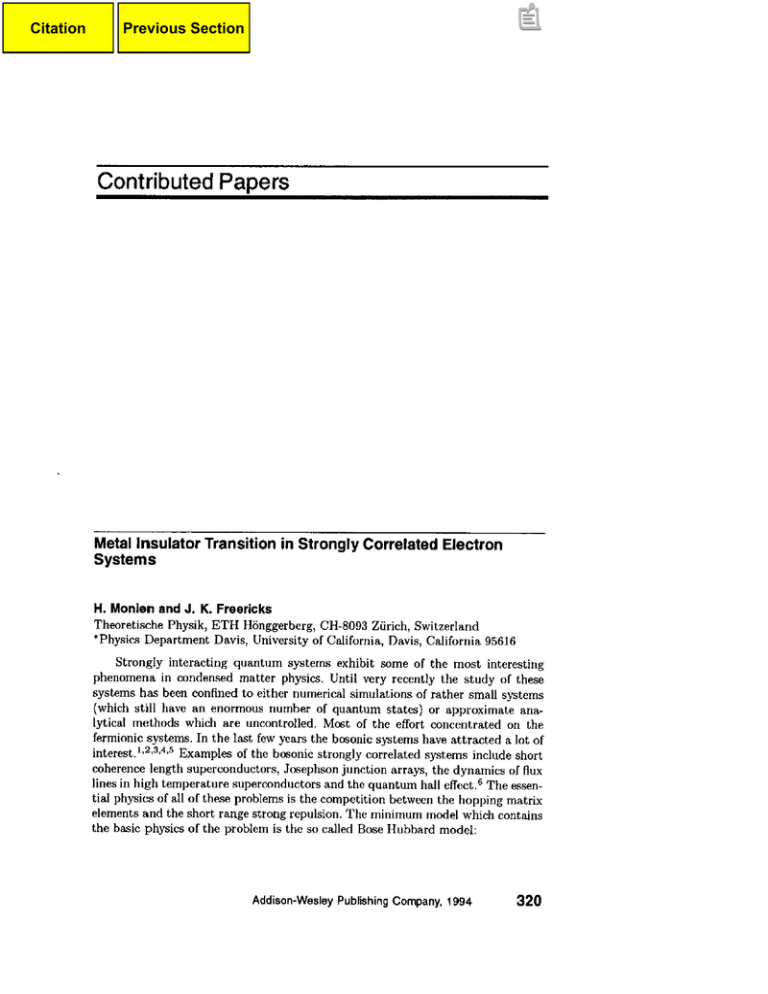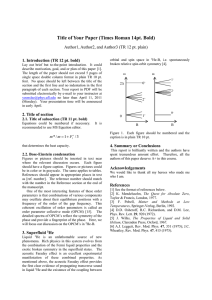Phase diagram of the Bose Hubbard model
advertisement

Citation Previous Section Contributed Papers Metal Insulator Transition in Strongly Correlated Electron Systems H. Monien and J. K. Freericka Theoretische Physik, ETH H6nggerberg, CH-8093 Zurich, Switzerland *Physics Department Davis, University of California, Davis, California 95616 Strongly interacting quantum systems exhibit same of the most interesting phenomena in condensed matter physi=. Until very recently the study of these systems has heen confined to either numerical simulations of rather small systems (which still have an enormous number of q“ant”m stat=) or approximate ~na. lytical methods which are uncontrolled. Mat of the effort concentrated on the fermionic systems. In the last few yearn the hmonic systems have attracted a lot of interest.l ,2,3,4,5 Example of the bmonic strongly correlated systems inc]ude ~h~rt coherence length superconductors, Jc6ephson junction arrays, the dynamics of flux lines in high temperature superconductors and the quantum hall effect.6 The ~ntial physics of all of these problems is the competition between the hopping matr~ elements and the short range strong repulsion. The minimum mdel which contains the bmicphysics of theproblem istheso called Bme Hubbard model: Addison-Wesley Publishing Company, 1994 320 H. Monien and J. K. Freericks H=–t~b~bJ–p~fii i.i where b< is the bmn annihilation operator at site i, t is the hopping matrix element between the site i and j, U is the strength of the on-site repulsion, and p isthecbemical potential. Tbe approximate form of the zero temperature (’T=O) ph= d]agram can be understood hy starting from the strong- mupling or “atomic” limit, ‘,7,8 In this limit, the kinetic energy vanishes (t = O) and every site is occupied byafixed number of bo30ns, no. The ground-state bwonoccupancy (no) is then chmn in such a way a.3 to minimize the on-site energy. For a finite deviation from integer filiing, afinite amount ofenergy (gap) isrequired tomovea particle through the lattice. The bmns are localized, producing aMott insulator. This energy gap decreas= with increming strength of the hopping matrix elements until it vankhe and the bmons condenw into the superfluid ph=e. A3 the strength of the hop ping matrix elements increms, therange of the chemical potential pabout wbih the system is incompr~sible decrea3=. The Mott-insulator phase will completely disappear at a critical value of thehopping matrix elements. The Hamiltonian, Eq. (l), h= been studied numerically with the Quantum Monte Carlo Method, e.g.,2 ,4,5 and analytically by mean field approximatiom,g renormalisation gr0up3,7 and other technique.s.5 Here we prewnt an analyti~l approachl” which fallows w to calculate the Mott-insulator . superfluid ph33e boundary at zero temperature with an accuracy comparable to the best available numerical results. We proceed % follows. We determine theenergy the of the Mott insulator in many bcdy perturbation theory in power3 of the kinetic energy. We compare the energy of the Mott - insulator with the energy of a m calld “defect state” in wbi& one additional boson (or one additional hole) is in an extendd state. The energy of the defect state is alwdetermind with many body perturbation theory. The Mott - insulator superfluid transition occurs when the energy of the’’defect state” and the Mott - insulator state are equal. Tozerothorderin t/U the Mott insulating state is given by. Tozeroth order in t/f/ the Mott imulating state is given by lwMott(no))(”) = fi ~ ,=,m where no is the and 10) is the particle (hole) “defwt state” theory @!)no 10) (2) number of b~mon each site, Nisthenumber ofsites in the lattice vacuum state. The defect pha3e is characterized by one additional which moves coherently throughout the lattice. Theansatz for tbe to zeroth order in t/fJis determined by degenerate perturbation l~De,(nO)):}t,c,e ‘0) ‘vDef(nO))hO’e = &~ fib~l~~ott(no))(o) ‘A~fib,l~Mott(no))(0) - A , (3) 322 3.0 ~ H. Monien and J. K. Freerbks 1 3.0 b) 2.0 F dtflt FIGURE 1. Ph& diagram of the Bc6e Hubbard model in one (left) and two (right)dimension. The WUarES (left) are the r-ults of the Quantum Monte Carlo calculation by Scalettar et al. for the one dimensional BHubbard model. The square (right) is the r=ult of the Quantum Monte Carlo calculation of Wlvedi et al. The hopping matrix element is scaled by the dimension d. where the fi is the eigenvector of the hopping matr~ tij with the 10w~t eigenvalue. The energiof three state can be calculated with Rayleigh-SchrHlnger perturbation theory. The result of the a third order perturbation calculation spialized to the hypercubic Iattim in one and two dimensions is shown in the Figure 1. We have repeatedly compared a strong-coupling expansion to the numerid QMC simulations for tbe incomprmsible-compr-ible phase boundary of the hose Hubbard model. A mem-field treatment of the hose Hubbard model (e.g. 1,9) cannot capture the physim of the one dimensional system which is completely dominated by fluctuations. The dimensionality only enters m a triviaf prefactor in integrals over the phase space. For this reason, mean-field theories will always give a concave shape H. klonieIl atld J. K. Reericks 323 to the Mott-insulator lobes independent of the dimension. A strong-coupling expmsion, on the other hand, e~ily distinguishthe shape difference from one dimension to higher dimensions md shows that a proper treatment of density fluctuations is critical in determining the Mott-insulator to superfluid transition. In conclusion we have described an analytical method to accurately calculate the ph~e diagram of the bme Hubbard model in my dimension. Extensions of these techniqum to include disorder will be prmented separately. ACKNOWLEDGMENTS We would like to thank R. Scalettar, G. Batrouni and K. Singh, for providing us with the Quantum Monte Culo data for the one dimensional bme Hubbard mndel and for many &ful discussions. This r=arch was supported in part by the NSF under Grant No. PHY89-04035 and DMR90-02492. REFERENCES 1. M. P. A. Fisher, P. B. Weichman, G. Grinstein, and D. S. F]sher, Phys. Rev. B40, 546 (1989). 2. R. T. Scalettar, G. G. Batrouni, and G. T. Zimanyi, Phys. Rev. Lett. 66, 3144 (1991), P. Niyaz, R.T. Scalettar, C.Y. Fong and G.G Batrouni, Phys. Rev. B44, 7143 (1991). G. G. Batrouni and R. T. Scalettar, Pbys. Rev. B46, W51 (1992). 3. D. S. Rokhsar and B. G. Kotliar, Phys. Rev. B 44, 10328 (1991); K. G. Singh and D, S. Rokhsar, Phys. WV, B46, 3002 (1992). 4. W. Krauth, M. Ctiwel, and J.P. Bouchaud, Phys. WV. B45, 3137 (1992); K. Sheshadri, H. R. Krishnarnurty, R. Pandlt and T. V. Ramkrishnan, Europhys. Lett, 22, 257 (1993). 5. W. Krauth and N. ‘Ttivedi, Europhysi@ btt. 14, 627 (1991); W. Krauth, N. ~ivedi, and D. Ceperley, Phys. Rev. Lett. 67,2307 (1991). 6. S. Klvelson, D. H. Lee, S, C. Zhang, Phys. Rev. B46, 2223 (1992). 7. T, Giamarchi and H. J. Schulz, Phys. Wv. B37, 325 (1988). 8. M. Ma, B. I. Halperin, and P. A. Lee, Phys. Rev. B34, 3136 (1986). 9. A. P. Kampf and G. T. Zimanyi, Phys. Rev. B47, 279 (1993). 10. J, K. Freericks and H. Monien, to be published. 11, The hopping matrix is -umed to have a nondegenerate Iow=t eigenvalue. 12. E.S. Sorensen, M. WaOin, S.M. Girvin, A.P. Young, Phys. Rev. Lett. 69, 828 (1992). 13. The compressibility is amumed to vanish continuously at the phase boundary. Next Section

